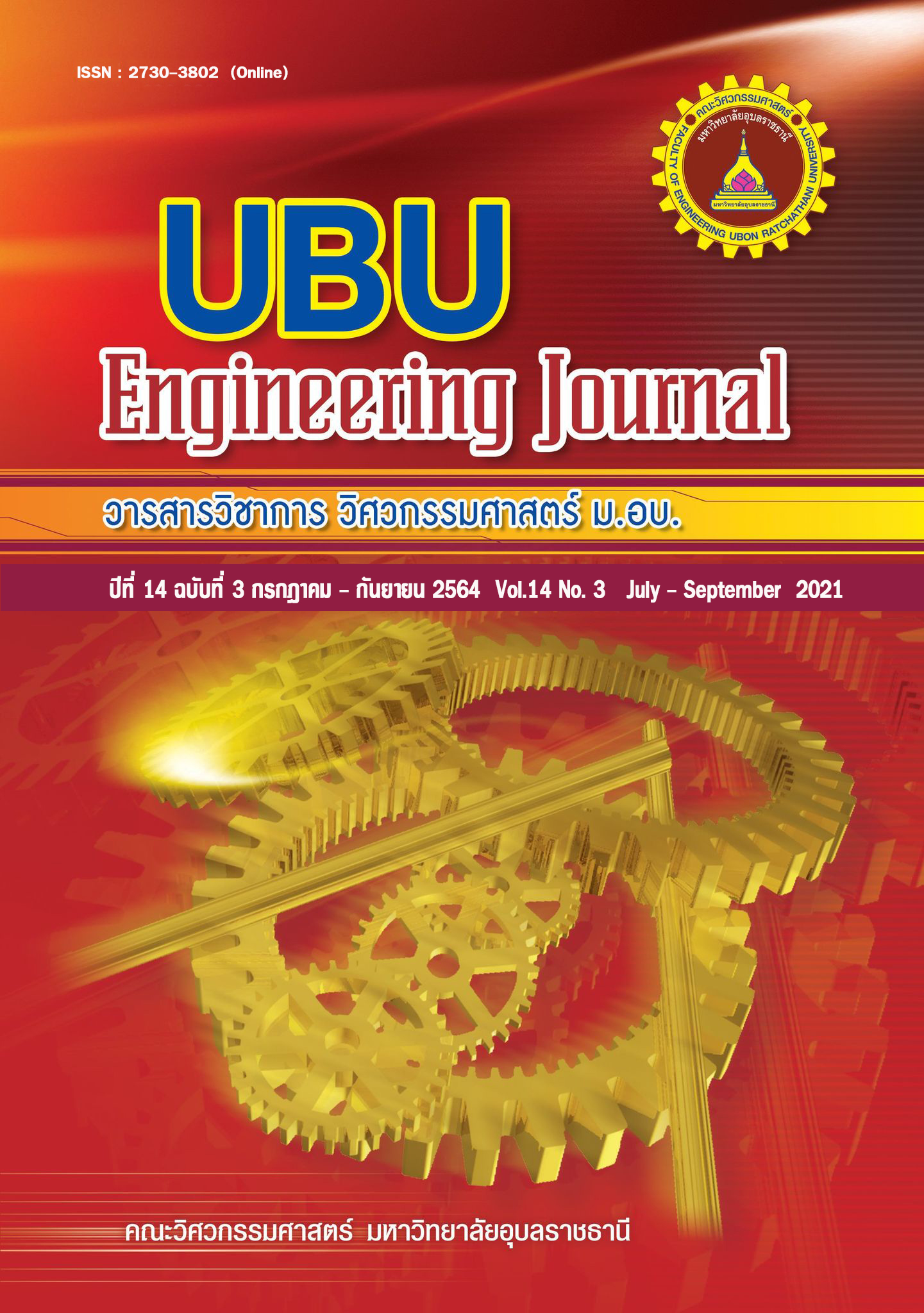การคาดการณ์ปริมาณการปล่อยก๊าซคาร์บอนไดอ๊อกไซด์ที่ลดลงจากการพัฒนาระบบรถไฟฟ้ารางเบาและการพัฒนาเน้นการขนส่งเชื่อมต่อโดยใช้วิธีบอททอมอัพ 2
Main Article Content
Abstract
This paper aims to the analyze and evaluate the reduction of carbon dioxide (CO2) emissions as a result of the development of Light Rail Transit (LRT), Transit-Oriented Development (TOD) as well as others supporting measures such as the improvement of the feeder systems and integrated ticket system in Khon Kaen town planning area. This research applied the Multimodal Travel Demand Model (MTDM) to estimate the travel demands in the study area in the year 2019 to 2049 and also adopt the Bottom-Up 2 method to calculate the amount of CO2 emissions under various set up scenarios. From the analysis result, it was found that when the LRT, TOD and other supporting measure development were implemented in 2021, 2025, 2029, 2039 and 2049 the magnitudes of CO2 emissions would reduce (when compared to the without project cases in the same year, equal to 1,296 (0.5%) 16,610 (6.1%) 36,430 (11.9%) 53,848 (13.3%) and 63,588 (13.3%) tons per year, respectively. In addition, in the 30 years period (from 2019 to 2049), the summation of the CO2 emission reduction will be approximately 1.23 million tons.
Article Details
References
[2] Shahbaz M, Loganathan N, Muzaffar AT, Ahmed K, Ali Jabran M. How urbanization affects CO 2 emissions in Malaysia? The application of STIRPAT model. Renew Sustain Energy Rev. 2016 May;57:83–93.
[3] Ali R, Bakhsh K, Yasin MA. Impact of urbanization on CO2 emissions in emerging economy: Evidence from Pakistan. Sustain Cities Soc. 2019 Jul;48:101553.
[4] Azam M, Khan AQ. Urbanization and environmental degradation: Evidence from four SAARC Countries-Bangladesh, India, Pakistan, and Sri Lanka. Environ Prog Sustain Energy. 2016 May;35(3):823–32.
[5] Dogan E, Turkekul B. CO2 emissions, real output, energy consumption, trade, urbanization and financial development: testing the EKC hypothesis for the USA. Environ Sci Pollut Res. 2016;23(2):1203–13.
[6] Ali HS, Abdul-Rahim A, Ribadu MB. Urbanization and carbon dioxide emissions in Singapore: evidence from the ARDL approach. Environ Sci Pollut Res. 2017;24(2):1967–74.
[7] Taylor MAP. Special issue on low carbon mobility. Int J Sustain Transp. 2017;11(1):1–2.
[8] International Energy Agency. Key world energy statistics. 2016. Available from: https://webstore.iea.org/key-world-energy-statistics-2018
[9] International Energy Agency. Policy Pathways: A Tale of Renewed Cities. 2013. Available from: http://www.iea.org/publications/freepublications/publication/policy-pathways---energy-efficiency-in-urban-transport-systems.html
[10] May AD. Developing Sustainable Urban Land Use and Transport Strategies A Decision Makers’ Guidebook. 2005.
[11] United Nation. The sustainable development goals report 2016. New York; 2016.
[12] Minken H, Jonsson D, Shepherd S, Jarvi T, May T, Page M, et al. Developing Sustainable Urban Land Use and Transport Strategies A Methodological Guidebook. 2003.
[13] May AD, Taylor MAP. KonSULT - an international knowledgebase on urban transport policy instruments. Transp Eng Aust. 2003;9(1):35–43.
[14] The University of Leeds. KonSULT, the Knowledgebase on Sustainable Urban Land use and Transport [Internet]. 2016 [cited 2020 May 19]. Available from: http://www.konsult.leeds.ac.uk/
[15] S6-5 Group. Designing Low-carbon Transport System for Khon Kaen City: Manual for estimation of CO2 emission reduction. Chiba, Japan; 2014.
[16] Nakamura H, Hayashi Y, May AD. Urban Transport and the Environment: An International Perspective. Elsevier Ltd; 2004.
[17] Klungboonkrong P, Jaensirisak S, Satiennam T. Potential performance of urban land use and transport strategies in reducing greenhouse gas emissions: Khon Kaen case study, Thailand. Int J Sustain Transp. 2017 Jan 2;11(1):36–48.
[18] Long S, Klungboonkrong P, Chindaprasirt P. Impacts of urban transit system development on modal shift and greenhouse gas (GHG) emission reduction: A Khon Kaen, Thailand case study. Eng Appl Sci Res. 2018;45(1):8–16.
[19] วิทยาลัยการปกครองท้องถิ่น. รายงานฉบับสมบูรณ์ (Final Report) โครงการวิจัยเรื่องการวิเคราะห์การลดการปล่อยก๊าซเรือนกระจกจากการพัฒนาระบบรถไฟฟ้ารางเบาในเขตเมืองขอนแก่น. ขอนแก่น; 2563.
[20] สำนักงานนโยบายและแผนการขนส่งและจราจร (สนข.). รายงานฉบับสมบูรณ์ โครงการศึกษาออกแบบรายละเอียดระบบขนส่งสาธารณะ ในเขตจังหวัดขอนแก่นและผลกระทบสิ่งแวดล้อม. มหาวิทยาลัยขอนแก่น; ขอนแก่น; 2561.
[21] Ninh T Van, Waisurasingha C. A Comparative Study of Applying Maximum Likelihood and Support Vector Machine Classifiers to Analyze Landsat Imagery for Evaluating Land Use Changes in Khon Kaen City, Thailand. KKU Res J (GRADUATE STUDY). 2017;17(4):49–60.
[22] Kelly C, May AD, Jopson A. The development of an option generation tool to identify potential transport policy packages. Transp Policy. 2008;15(6):361–71.
[23] May AD, Kelly C, Shepherd S, Jopson A. An option generation tool for potential urban transport policy packages. Transp Policy. 2012;20:162–73.
[24] Citilabs. Transportation & Land-Use Solutions. 2016. Available from: http://www.citilabs.com/
[25] องค์การบริหารก๊าซเรือนกระจก. รายงานฉบับสมบูรณ์ (Final Report) โครงการศึกษาและจัดทำ Baseline การปล่อยก๊าซเรือนกระจกจากภาคขนส่งในจังหวัดนำร่องและการศึกษาแนวทางในการส่งเสริมกิจกรรมลดการปล่อยก๊าซเรือนกระจกจากภาคขนส่ง. ขอนแก่น; 2555.
